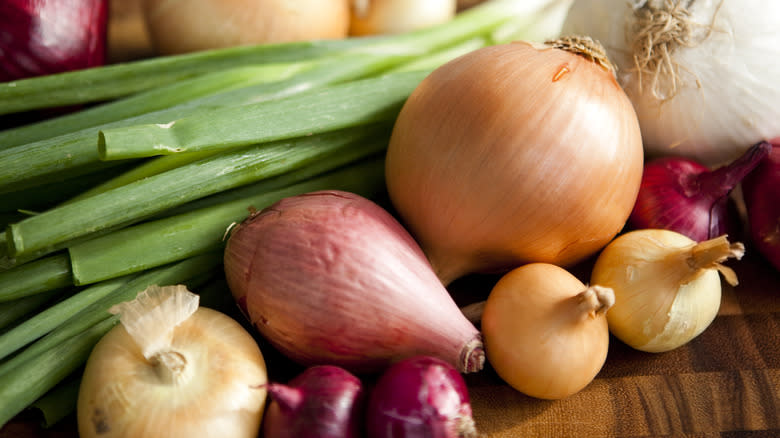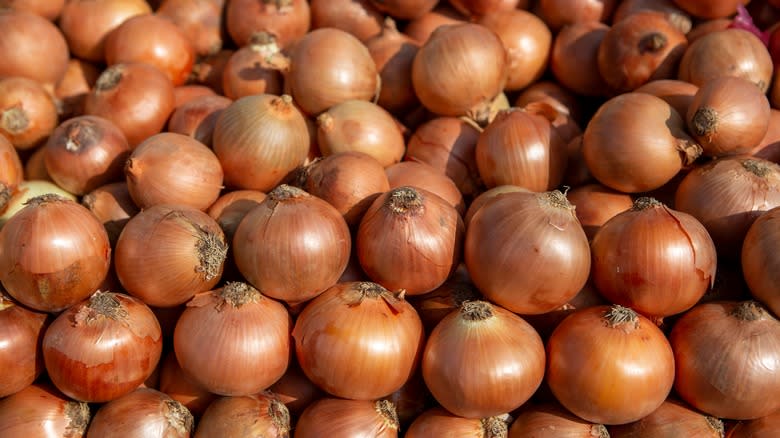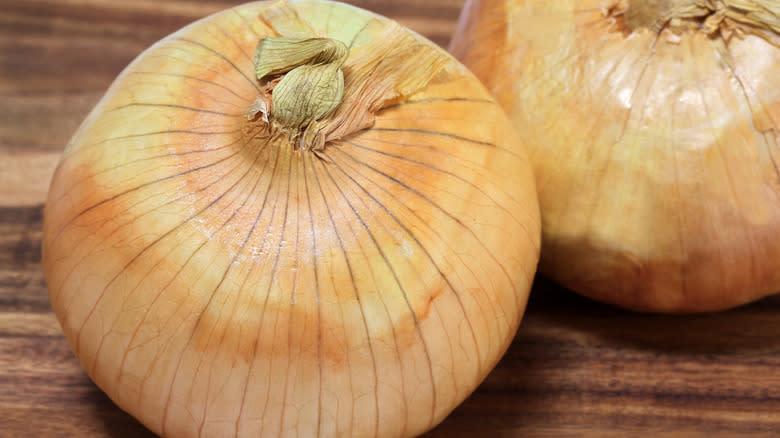Yellow Onions Vs. Sweet Onions: What's The Difference?

Onions are the workhorse vegetable of every kitchen. They can stand out or slide into most dishes, enriching and enhancing a variety of cuisines. Think of the exquisite umami sweetness of Thai crispy fried shallots, or the clean crunch of chopped white onions in Mexican ceviche. When you're shopping for onions at the supermarket, there are two types of onions in particular that may be difficult to tell apart: yellow and sweet. Is there actually a distinction with a difference? Absolutely: Sweet onions are best used fresh or in sweet dishes like jams. Yellow onions are best cooked and caramelized. Caramelized sweet onions can actually throw a savory dish out of balance, as they can be too sweet.
Granted, both yellow and sweet onions resemble each other. Since both are yellow, they're more similarly colored than red onions; they're more alike in size and shape to each other than with shallots or scallions. If you look closely, however, you'll see that sweet onions are larger than yellow onions, and have a lighter and more transparent skin. But the biggest difference between the two is on the inside, particularly in their respective amounts of sulfur and sugar (because, let's face it -- that's pretty much all onions are: sulfur compounds, fructose, and water).
Read more: What These Imitation Foods Are Actually Made Of
Yellow Onoins Are Here To Do The Work

Yellow onions are the ones to buy when recipes don't specify a particular type of allium to use. They're right at home in dishes from around the world, sauté like a dream, and caramelize like a champ because of their hardy texture. Yellow onions have a more assertive smell and flavor which is almost entirely due to their high sulfur content. If you want to know why you cry when you chop yellow onions, or how they last so long in storage, you have sulfur to thank.
Sulfur dissipates as an onion is cooked, while its sugars are brought to the fore. This is why yellow onions do so well when roasted, or deeply browned in a French onion soup or Spanish frittata: they're the cooking onion. Unless you're a sucker for pungency (or need a good cry), you don't tend to eat yellow onions raw. For every other conceivable cooking application, though, they've got you covered.
Sweet Onions Have Their Season

By contrast, if there's any onion you can bite into like an apple, it's a sweet onion. This is because, no matter where the variety originates -- a Vidalia from the state of Georgia, or a Texas Sweet, or a Hawaiian Maui -- sweet onions are grown in sulfur-poor soil and therefore have half or less than half the amount of sulfur as their yellow cousins. This makes them milder and less pungent in aroma and flavor, while also (because of their higher water and sugar content) giving them a shorter shelf life. Whereas yellow onions will last four to six weeks in the pantry, sweet onions should be refrigerated and eaten shortly after purchase.
So, when should you be using sweet onions? Raw, certainly -- shaved into salads or sitting on top of a freshly grilled hamburger. They're amazing when sliced thick and fried into onion rings, or caramelized into a deep golden brown and combined with vinegar to make an onion jam. Remember that sweet onions tend to be more seasonal than other varieties, and are widely available in the spring and summer. Think of the freshness of dishes from that time of year, and you'll see that, yet again, fresh foods come into our lives at just the right time.
Read the original article on Daily Meal.

